Healthcare Biometrics Market Size
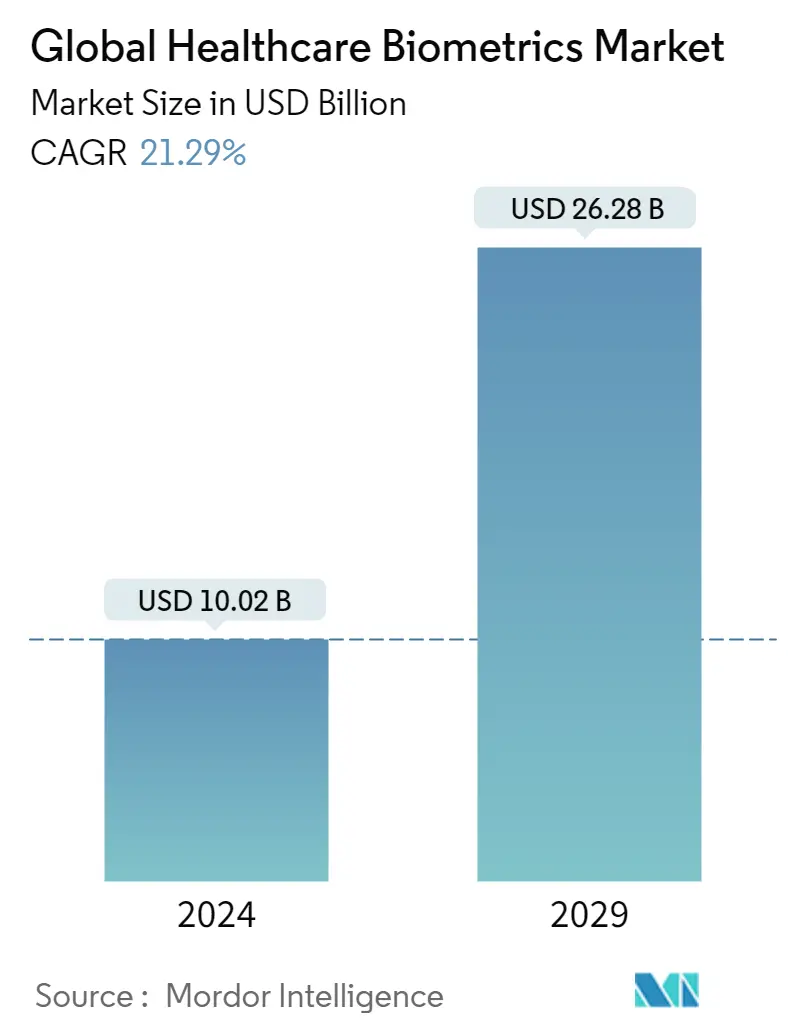
| Study Period | 2019 - 2029 |
| Market Size (2024) | USD 10.02 Billion |
| Market Size (2029) | USD 26.28 Billion |
| CAGR (2024 - 2029) | 21.29 % |
| Fastest Growing Market | Asia Pacific |
| Largest Market | North America |
Major Players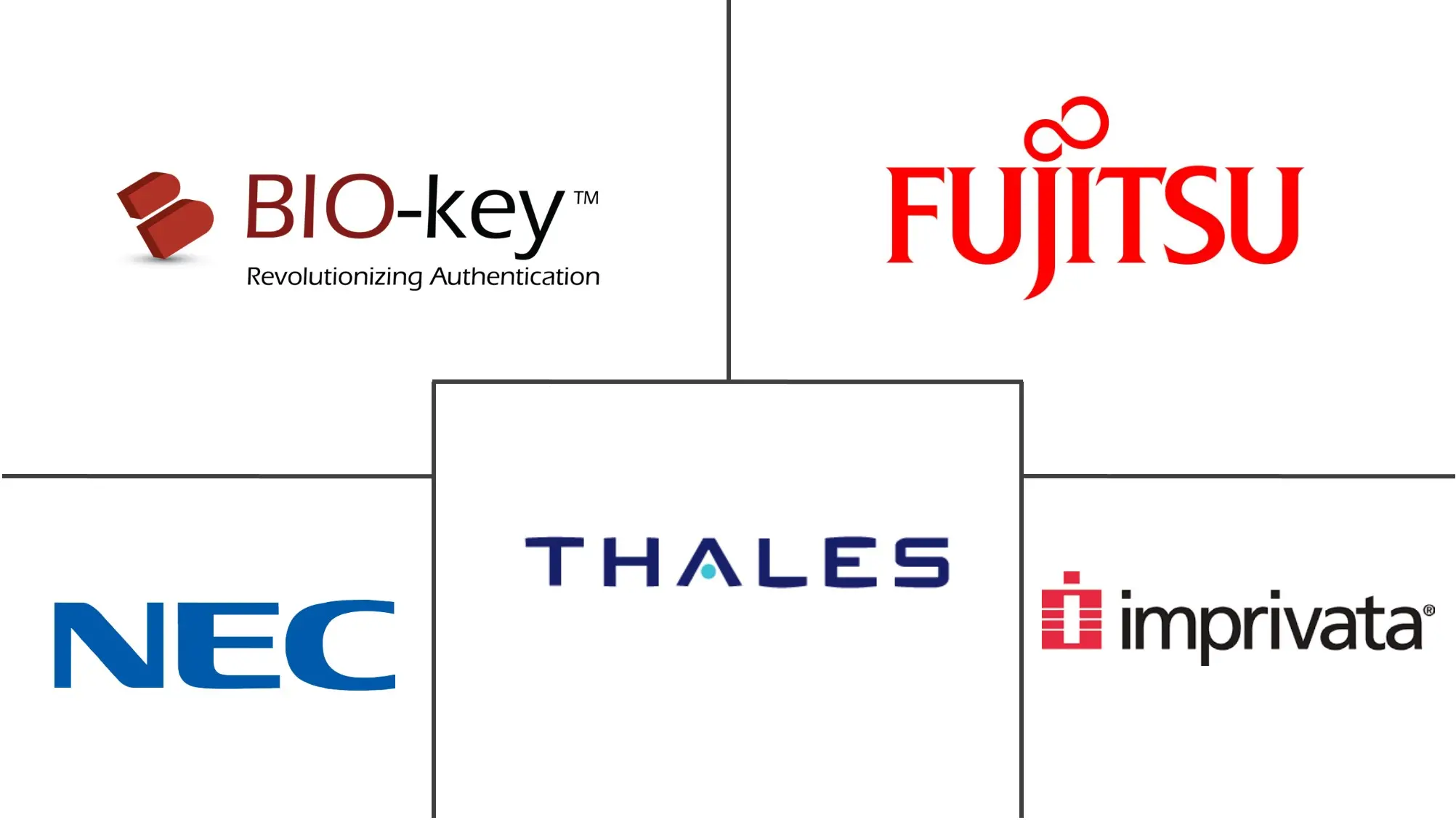
*Disclaimer: Major Players sorted in no particular order |
Healthcare Biometrics Market Analysis
The Global Healthcare Biometrics Market size is estimated at USD 10.02 billion in 2024, and is expected to reach USD 26.28 billion by 2029, growing at a CAGR of 21.29% during the forecast period (2024-2029).
The main challenge for the healthcare system in many countries was to limit the spread of COVID-19 among people and provide the best care to infected patients and decrease the number of possible deaths. A profound impact on the healthcare biometrics market was observed as well. According to the article published in 'Biometric Technology Today' in April 2020, the COVID-19 circumstance necessitates the implementation of contactless and efficient operations, particularly in retail. Contactless technologies such as face and iris-based detection systems are being pushed to new heights, while applications that rely on fingerprint recognition modalities suffer a substantial loss due to the COVID-19 pandemic's increasing criteria. Furthermore, Covid-19 will also have a significant and long-term impact on biometrics companies, developers, investors, and customers. For instance, as per the study published in April 2020, titled 'Impact on Biometrics of Covid-19', the most immediate impact of Covid-19 is that contactless technologies like face and iris recognition are now being forced to adapt to the emergent threat. Biometric AI and ML algorithms are being pushed to new heights to extend governments' protective, monitoring, and screening reach. According to recent government regulations, organizations must avoid utilizing palm print, fingerprint, and hand-key scanners to prevent physical contact and virus spread. These steps are paving the way for user-friendly iris scans and facial recognition technology that may be used in a variety of settings.
Healthcare biometrics refers to different biometric applications used in hospitals and clinics to monitor patients' health. Different initiatives are taken by the government in the field of healthcare biometrics due to the rise in healthcare fraud and to increase security for protecting healthcare information driving the market for healthcare biometrics. For instance, in August 2022, The French parliament (Assemblée Nationale) voted for a new EUR 20 million (roughly USD 20.4 million) project 242-95 to establish a biometric version of citizens' health cards (Carte Vitale).
Furthermore, emerging applications across novel fields of clinical research of medical devices are expected to open new avenues in the biometric healthcare market. Also, the increase in government initiatives toward healthcare infrastructure in developing countries drives the global healthcare biometric market.
Additionally, the key activity by the market players, such as expansion and product launch, is anticipated to drive market growth. For instance, in November 2021, ZKTeco reported the opening of a new factory in Bangalore, India, claiming that this would pave the way for new possibilities and business opportunities. Which aims to develop a modern and efficient infrastructure base to open up new opportunities for local production and workforce procurement, as well as create a conducive eco-system for the Biometric and Security Industry.
However, factors such as consumer acceptance and the high cost of healthcare biometric devices impede market growth.
Healthcare Biometrics Market Trends
This section covers the major market trends shaping the Healthcare Biometrics Market according to our research experts:
Multifactor-factor Authentication is Expected to Cover a Large Share of the Market Over the Forecast Period
Adding more authentication factors expands the security of any access management solution into multi-factor authentication (MFA). MFA offers scalable, tiered levels of security that can be deployed for controlling access to the most sensitive of data. Medical information, databases, and other valuable information should all deploy various levels of MFA, incorporating several factors, which can include passwords, secret questions, OTPs, location, user behavior, registered mobile devices, etc., other than biometrics.
According to the study titled "Advances in Feature Transformation based Medical Decision Support Systems for Health Informatics," published in the Hindwi Journal in March 2022, most biometrics authentication in healthcare is used for patient tracking and monitoring, although usage for access control, identification, workforce management, and patient record storage is also increasing. Hence all these factors, coupled with the safety of MFA over traditional methods, are expected to help the growth of the market.
However, technological advancements in the MFA system, such as touchless and face detection. The touchless MFA increased the safety and convenience of the clinician. For Instance, in June 2020, Caregility's telehealth platform has single sign-on (SSO) and multi-factor authentication (MFA) capabilities. End users can log into the platform with a single set of credentials and gain access to the various apps, websites, and data for which they have permissions, thanks to SSO enhancements. By reducing password fatigue, the feature improves security and system usability, as well as employee satisfaction.
Thus all aforementioned factors are expected to boost the segment growth over the forecast period.
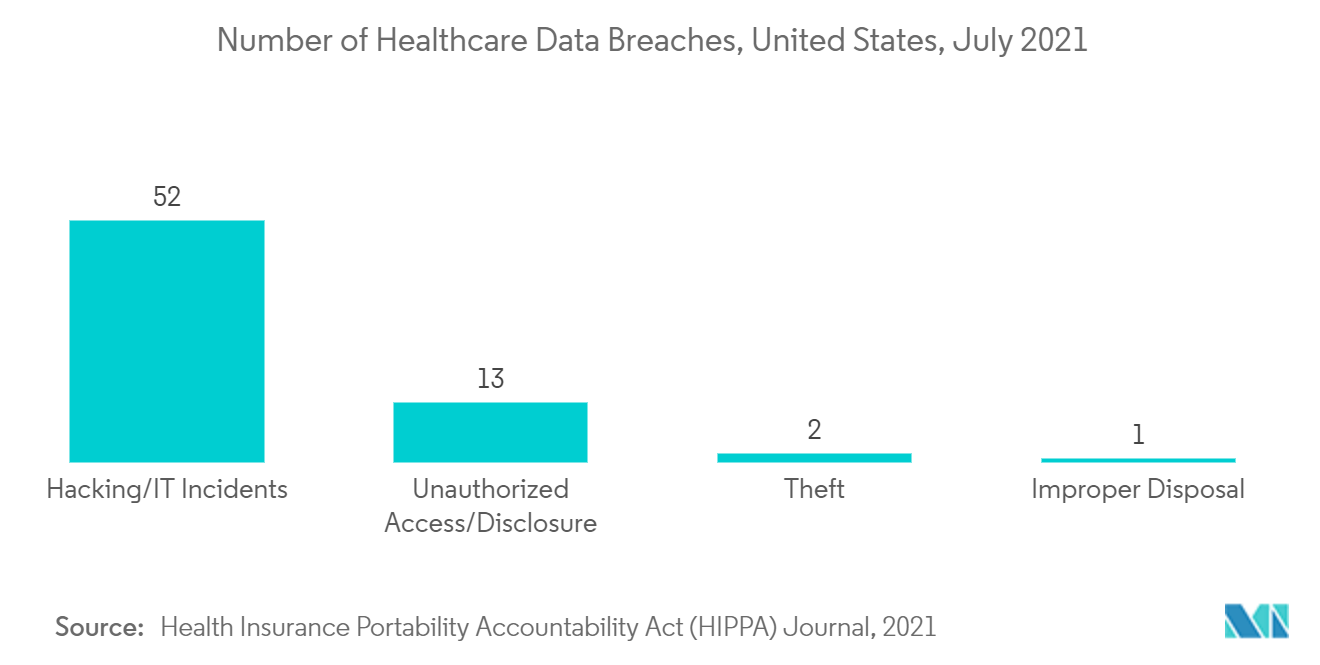
North America is Expected to Dominate the Healthcare Biometrics Market During the Study Period
The North American region is expected to increase due to the high number of frauds and crimes occurring in the healthcare sector. The presence of a high incidence of fraudulent activities is expected to increase the rate of adoption of these technologically advanced biometric systems to gather patient data and registration data. Furthermore, the establishment of new healthcare facilities such as hospitals and clinics may act as a primary driving force for the growth of this market in the region.
Furthermore, several companies are starting various strategies like collaboration, new product launches, mergers, and acquisitions to maintain and increase their market share. For instance, in June 2021, Clear signed up for Atlantic Health as a partner for the digital ID provider's Health Pass, which features face biometrics for credential-binding and data security, to provide the health care network's patients with a digital proof of COVID-19 vaccination.
Moreover, various strategic activities adopted by the key market players, such as mergers and acquisitions, product launches, and partnerships, anticipated market growth. For instance, in February 2022, rf IDEAS partnered with ID R&D to bring its market-leading biometric authentication and anti-spoofing products to the rf IDEAS portfolio.
Additionally, in May 2021, Imprivata launched face biometrics for healthcare through the Aware and Idemia partnership. The new mobile face biometrics solution is intended to enable simplified self-enrollment for electronic prescriptions for controlled substances (EPCS) in compliance with the United States Drug Enforcement Agency (DEA) regulations.
Thus, owing to the above-mentioned factors, it is expected to aid the growth of the market studied in the North American region over the forecast period.
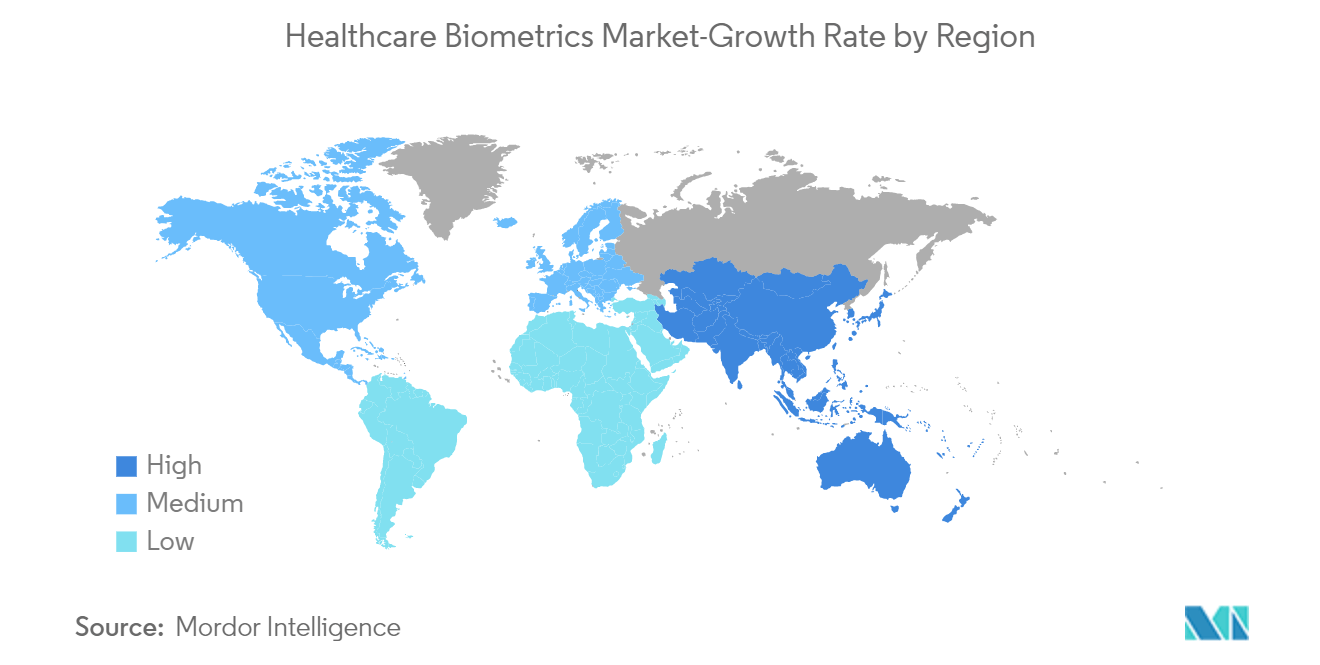
Healthcare Biometrics Industry Overview
The majority of the healthcare biometrics are being manufactured by the global key players. Joint ventures and collaborations amongst the players can be expected in the forecast period. These systems, combined with rising awareness levels and seamless integration solution systems across different verticals, are a few key strategies that are expected to be implemented by the players. Some of the market players are Thales Group, Bio-Key International Inc., Fujitsu Limited, Imprivata Inc., and NEC Corporation.
Healthcare Biometrics Market Leaders
-
Thales Group
-
Bio-Key International Inc
-
Fujitsu Limited
-
Imprivata Inc
-
NEC Corporation
*Disclaimer: Major Players sorted in no particular order
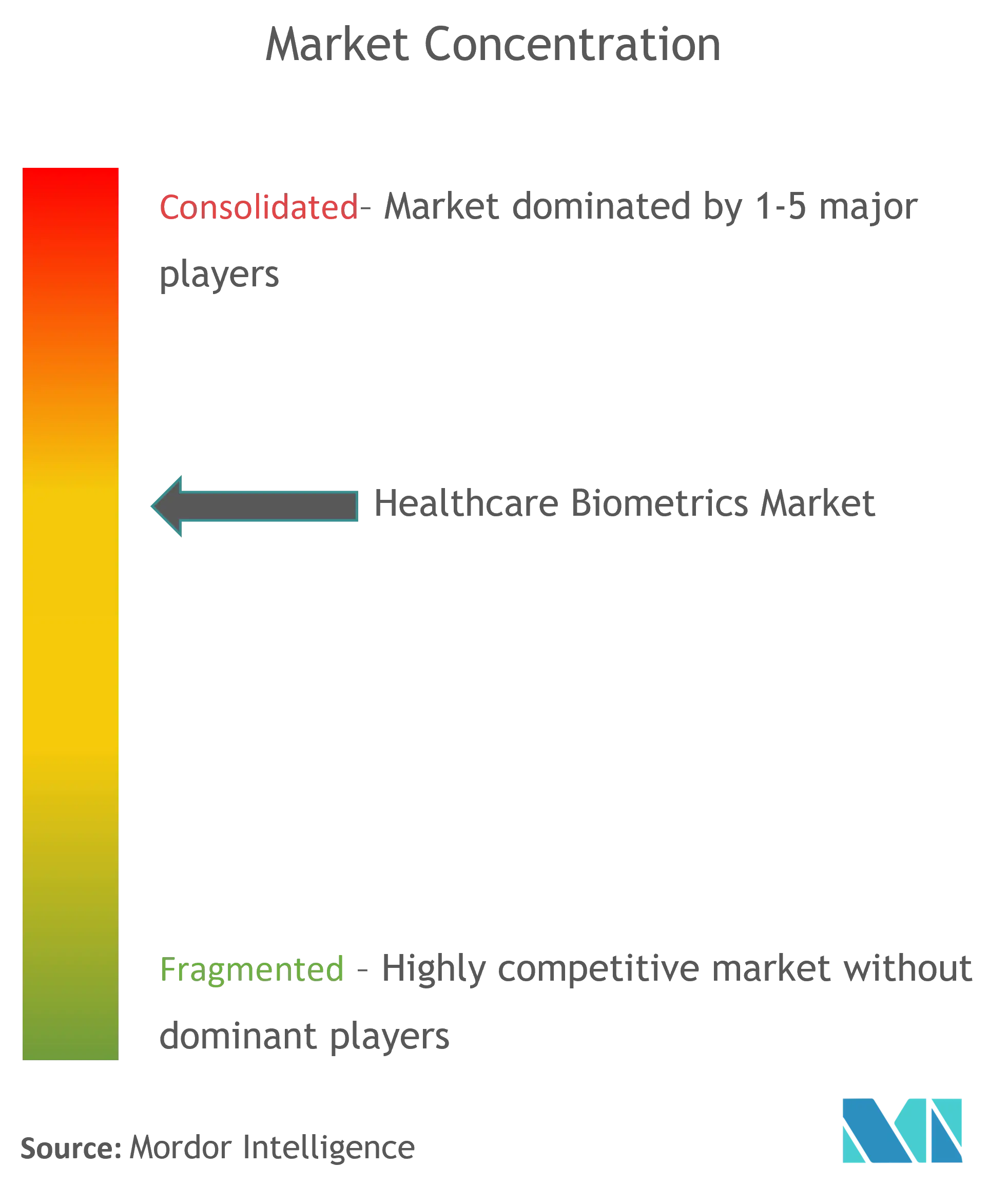
Healthcare Biometrics Market News
- In March 2022, BioIntelliSense, has launched its medical-grade BioButton Rechargeable wearable device. The new BioButton Rechargeable device allows for continuous multi-parameter monitoring of a broad range of 20+ vital signs and physiologic biometrics for up to 30 days on a single charge, based on configuration.
- in January 2022, Mitsubishi Electric Corporation unveiled HealthCam, a facial recognition health monitoring system that can track an individual's heartbeat rate, blood oxygen level, temperature, as well as other health indicators.
Healthcare Biometrics Market Report - Table of Contents
1. INTRODUCTION
- 1.1 Study Assumptions and Market Definition
- 1.2 Scope of the Study
2. RESEARCH METHODOLOGY
3. EXECUTIVE SUMMARY
4. MARKET DYNAMICS
- 4.1 Market Overview
-
4.2 Market Drivers
- 4.2.1 Implementation of Government Initiatives Supporting the Adoption of Biometrics in Healthcare
- 4.2.2 Rising Incidence of Healthcare Data Breaches and Medical Identity Theft
-
4.3 Market Restraints
- 4.3.1 High Cost of Biometric Devices
- 4.3.2 Issues Related to the Use of Biometric Technologies
-
4.4 Porter's Five Forces Analysis
- 4.4.1 Threat of New Entrants
- 4.4.2 Bargaining Power of Buyers/Consumers
- 4.4.3 Bargaining Power of Suppliers
- 4.4.4 Threat of Substitute Products
- 4.4.5 Intensity of Competitive Rivalry
5. MARKET SEGMENTATION (Market Size by Value - USD million)
-
5.1 By Technology
- 5.1.1 Single-factor Authentication
- 5.1.2 Multi-factor Authentication
- 5.1.3 Other Technologies
-
5.2 By Application
- 5.2.1 Medical Record and Data Center Security
- 5.2.2 Patient Identification and Tracking
- 5.2.3 Care Provider Authentication
- 5.2.4 Home/Remote Patient Monitoring
- 5.2.5 Other Applications
-
5.3 By End User
- 5.3.1 Hospital/Clinics
- 5.3.2 Research and Clinical Laboratory
- 5.3.3 Other End Users
-
5.4 Geography
- 5.4.1 North America
- 5.4.1.1 United States
- 5.4.1.2 Canada
- 5.4.1.3 Mexico
- 5.4.2 Europe
- 5.4.2.1 Germany
- 5.4.2.2 United Kingdom
- 5.4.2.3 France
- 5.4.2.4 Italy
- 5.4.2.5 Spain
- 5.4.2.6 Rest of Europe
- 5.4.3 Asia-Pacific
- 5.4.3.1 China
- 5.4.3.2 Japan
- 5.4.3.3 India
- 5.4.3.4 Australia
- 5.4.3.5 South Korea
- 5.4.3.6 Rest of Asia-Pacific
- 5.4.4 Middle-East and Africa
- 5.4.4.1 GCC
- 5.4.4.2 South Africa
- 5.4.4.3 Rest of Middle-East and Africa
- 5.4.5 South America
- 5.4.5.1 Brazil
- 5.4.5.2 Argentina
- 5.4.5.3 Rest of South America
6. COMPETITIVE LANDSCAPE
-
6.1 Company Profiles
- 6.1.1 Zkteco, Inc
- 6.1.2 Thales Group
- 6.1.3 Bio-Key International Inc
- 6.1.4 Crossmatch Technologies Inc
- 6.1.5 Fujitsu Limited
- 6.1.6 Imprivata Inc
- 6.1.7 Lumidigm
- 6.1.8 Morpho
- 6.1.9 NEC Corporation
- 6.1.10 Suprema Inc
- 6.1.11 Integrated Biometrics
- 6.1.12 Facetec Inc.
- *List Not Exhaustive
7. MARKET OPPORTUNITIES AND FUTURE TRENDS
** Subject To AvailablityHealthcare Biometrics Industry Segmentation
Healthcare biometrics refers to different biometric applications used in hospitals and clinics to monitor the health of patients. It allows users to access applications and patient data quickly and get instant access to the records they need. The market is segmented by Technology (Single-factor Authentication, Multi-factor Authentication, and Other Technologies), Application (Medical Record and Data Center Security, Patient Identification and Tracking, Care Provider Authentication, Home/Remote Patient Monitoring, Other Applications), End User (Hospital/Clinics, Research and Clinical Laboratory, Other End Users) and Geography (North America, Europe, Asia-Pacific, Middle East & Africa, and South America). The market report also covers the estimated market sizes and trends for 17 different countries across major regions globally. The report offers the value (in USD million) for the above segments.
| By Technology | Single-factor Authentication | |
| Multi-factor Authentication | ||
| Other Technologies | ||
| By Application | Medical Record and Data Center Security | |
| Patient Identification and Tracking | ||
| Care Provider Authentication | ||
| Home/Remote Patient Monitoring | ||
| Other Applications | ||
| By End User | Hospital/Clinics | |
| Research and Clinical Laboratory | ||
| Other End Users | ||
| Geography | North America | United States |
| Canada | ||
| Mexico | ||
| Geography | Europe | Germany |
| United Kingdom | ||
| France | ||
| Italy | ||
| Spain | ||
| Rest of Europe | ||
| Geography | Asia-Pacific | China |
| Japan | ||
| India | ||
| Australia | ||
| South Korea | ||
| Rest of Asia-Pacific | ||
| Geography | Middle-East and Africa | GCC |
| South Africa | ||
| Rest of Middle-East and Africa | ||
| Geography | South America | Brazil |
| Argentina | ||
| Rest of South America |
Healthcare Biometrics Market Research FAQs
How big is the Global Healthcare Biometrics Market?
The Global Healthcare Biometrics Market size is expected to reach USD 10.02 billion in 2024 and grow at a CAGR of 21.29% to reach USD 26.28 billion by 2029.
What is the current Global Healthcare Biometrics Market size?
In 2024, the Global Healthcare Biometrics Market size is expected to reach USD 10.02 billion.
Who are the key players in Global Healthcare Biometrics Market?
Thales Group, Bio-Key International Inc, Fujitsu Limited, Imprivata Inc and NEC Corporation are the major companies operating in the Global Healthcare Biometrics Market.
Which is the fastest growing region in Global Healthcare Biometrics Market?
Asia Pacific is estimated to grow at the highest CAGR over the forecast period (2024-2029).
Which region has the biggest share in Global Healthcare Biometrics Market?
In 2024, the North America accounts for the largest market share in Global Healthcare Biometrics Market.
What years does this Global Healthcare Biometrics Market cover, and what was the market size in 2023?
In 2023, the Global Healthcare Biometrics Market size was estimated at USD 8.26 billion. The report covers the Global Healthcare Biometrics Market historical market size for years: 2019, 2020, 2021, 2022 and 2023. The report also forecasts the Global Healthcare Biometrics Market size for years: 2024, 2025, 2026, 2027, 2028 and 2029.
Healthcare Biometrics Industry Report
Statistics for the 2024 Healthcare Biometrics market share, size and revenue growth rate, created by Mordor Intelligence™ Industry Reports. Healthcare Biometrics analysis includes a market forecast outlook to 2029 and historical overview. Get a sample of this industry analysis as a free report PDF download.



